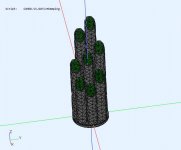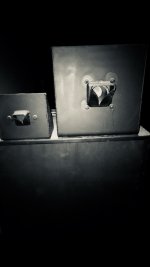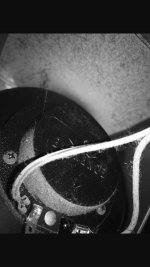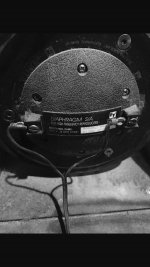I thought referencing to this thread was a good idea🙂
Karlson tube HF waveguides - how many have tried them?
Karlson tube HF waveguides - how many have tried them?
hey pelanj - one of my double slotted K-tubes snapped right at the mounting base. I glued it back on. Sometime, might you make the joint area between the mounting base and tube stronger?
Hi Freddi, I see I did not make a fillet at the base. A fillet should make it much stronger, but will need a chamfer on the mounting hole if mounting from the back. There are 2mm and 5mm versions, I think I have 2 mm on the other K-tubes.
How do they measure and sound? I still have only one that measured quite nicely, I never got to printing another one to test fully. There are many half finished projects slowly moving forward at the moment🙂
How do they measure and sound? I still have only one that measured quite nicely, I never got to printing another one to test fully. There are many half finished projects slowly moving forward at the moment🙂
Attachments
I'm still recovering at my kid's and his GF's place so don't have freedom to play with stuff - - will try to rework an old crossover and give it a run in a few days. It seems odd that having the slots on "top and bottom" would give the most even horizontal dispersion. Why might that be?
Last edited:
I have no idea to be honest. Maybe if Don VK would have a bit of time to run a FEM simulation on it? What happens there is far beyond my knowledge.
I'd like Don VK's thoughts on making smooth playing regular style K - is there one front chamber shape aspect "better" than another? How would Don make a new K from scratch and how might it differ from Karlson's originals ?
I know one is dealing with cavity peak. backwave fill (if vented) , driver parameters - response and enclosure size.
Original Karlson and the new Karlsonator can sound very good imo (and without any front chamber damping materials in some cases)
I'd like to have a Karlson midrange module using a pro 6.5 or 8" - that should not have to be made large if dealing with say a 200Hz low end. (my drivers are 6PEV13 and 8PL21)
I know one is dealing with cavity peak. backwave fill (if vented) , driver parameters - response and enclosure size.
Original Karlson and the new Karlsonator can sound very good imo (and without any front chamber damping materials in some cases)
I'd like to have a Karlson midrange module using a pro 6.5 or 8" - that should not have to be made large if dealing with say a 200Hz low end. (my drivers are 6PEV13 and 8PL21)
Last edited:
my test gear is at my house and I've been trying to recover at my kid's place - where little playing - or spl can be tolerated. I'll try to do some subjective comparisons


I'd like Don VK's thoughts on making smooth playing regular style K - is there one front chamber shape aspect "better" than another? How would Don make a new K from scratch and how might it differ from Karlson's originals ?
I know one is dealing with cavity peak. backwave fill (if vented) , driver parameters - response and enclosure size.
Original Karlson and the new Karlsonator can sound very good imo (and without any front chamber damping materials in some cases)
I'd like to have a Karlson midrange module using a pro 6.5 or 8" - that should not have to be made large if dealing with say a 200Hz low end. (my drivers are 6PEV13 and 8PL21)
That is really awesome! Here are my measurements to compare. Zero is here the axis of the tube and below means the side with the slot, it was pointed with the slot down when I tested them (but it may be the opposite, I do not remember exactly...). So the simulation confirms, that the ripple is inherent to the tube.
Related to this topic, multiple tubes to reduce ripple ? There are some simulation results for smoothing out the ripple at:
MDD Multi Delays Diffraction (Multi TL, omnidirectional, single drive, ...)
.
Attachments
subjective pecking order out of these three 1-Best to 3=Worst with no highpass EQ and a DE250 - same L-pad setting
1 = double slotted tube - lots of HF above and below the tube as oriented in picture below
2 = mini klam -not quite as loud as double slot tube - very little HF above its top boundary
3 = B&O type deflector - least energetic - seems to have a narrow vertical window (?)
DonVK - the K-tube (single or double slotted) is plenty smooth - it would be interesting to use multiple tubes
in a forwards pointing arrangement to gain some power on cymbals and snare rimshots.
I'd like your th0ughts on the traditional Karlson arrangement with regards to front chamber shape and proportions. How might those matter for a fixed front chamber volume? Are port placement and area more important?

1 = double slotted tube - lots of HF above and below the tube as oriented in picture below
2 = mini klam -not quite as loud as double slot tube - very little HF above its top boundary
3 = B&O type deflector - least energetic - seems to have a narrow vertical window (?)
DonVK - the K-tube (single or double slotted) is plenty smooth - it would be interesting to use multiple tubes
in a forwards pointing arrangement to gain some power on cymbals and snare rimshots.
I'd like your th0ughts on the traditional Karlson arrangement with regards to front chamber shape and proportions. How might those matter for a fixed front chamber volume? Are port placement and area more important?

Last edited:
I also prefer the double cutaway K-Tube I mount it so the slot openings face up and down and I set the tube centred upon my seated ear height firing very close to directly at my ears, I generally start my setup so that I am looking directly down the the centre of both K-Tubes and then adjust toe in or out as desired. I can achieve excellent stage and image in this way.
hi pelanj
that tube is beyond repair
my kid tried to move the CD w. tube by picking it up by the tube - snapping it off again then I goofed and split the tube parts in an attempt to superglue it back together. (held it near the tip rather than base of the double tube)
Is there something to specify during printing to make the assembly stronger at the base? It might be ok to use epoxy putty there -- if it will stick.
that tube is beyond repair
my kid tried to move the CD w. tube by picking it up by the tube - snapping it off again then I goofed and split the tube parts in an attempt to superglue it back together. (held it near the tip rather than base of the double tube)
Is there something to specify during printing to make the assembly stronger at the base? It might be ok to use epoxy putty there -- if it will stick.
Hi Freddi, you can print with more perimeters (thicker shell) and more infill would make it stronger. Also, a little higher temperature and no cooling makes a stronger part. The tubes I printed are pretty strong with the default setting, which are 3 perimeters = cca 1.2 mm wall thickness + 20 % infill, PLA at 210 and no cooling.
thanks pelanj - the guy who printed my stuff seemed to have some problems - maybe I can find someone more adept
hey Pelanj - testing some Altec 807 "Symbiotik" CD and grabbed a mini klam as the closest thing handy - that mini klam sounded very good compared to the bare driver exit, so may have merit for some applications - let the forum know impressions good / bad if you get time to try one with music. It might have to have its nose pointed at the listener (?)
Freddi, I currently have no speaker to go below a mini-klam, all is now WIP. What do you use below it and what is the crossover point?
had a Beta8cx below it and guessing xover to be around 2K8 (4uF/0.35mH/12uF - those old Altec Symbiotik drivers are sweet and lack of lower F support probably flattened its response vs being on Altec 811 or 511 horn. The mini klam might be usable pointing nearly straight up - ?
- Home
- Loudspeakers
- Multi-Way
- 3D printed K-Tube for 1" compression drivers



